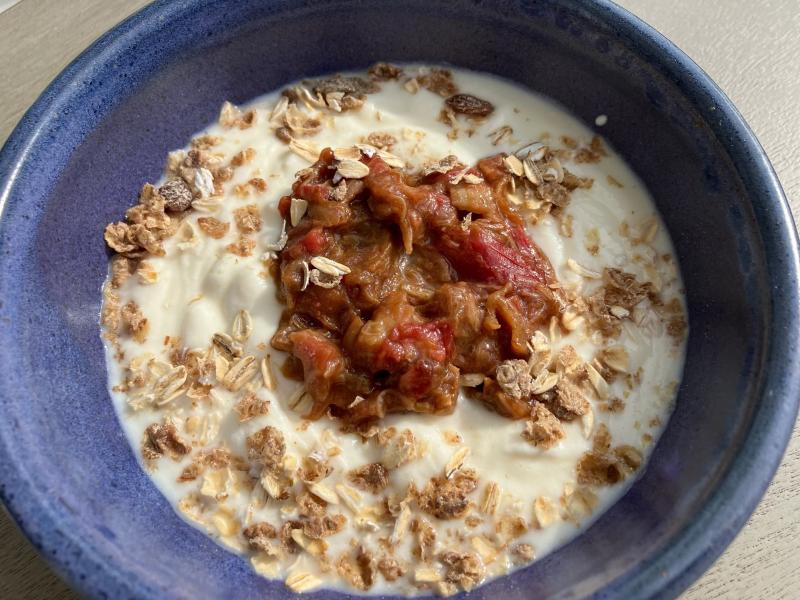Rhubarb recipes depend on balancing sweet-tart flavors
Once again, the appearance of rhubarb stalks in the produce aisle at Lloyd’s Market tells us the growing season is underway and harvest has begun. Rhubarb has a short season that runs from late April to early June, and its signature color is expected to be bright red. But, beneath that thin exterior layer of the stalk, the flesh is more often bright green. And, when I cooked the rhubarb compote in the photo, it appeared far more green than red.
Why is the rhubarb green? This is not an indication of ripeness or readiness to harvest, but of the variety that has become popular. The stalks were deep reddish at the base, but far less red in color the rest of the way up. I have come to discover that the color change is due to preference for specific strains that are quicker to market, have a better yield and are less stringy than their crimson cousins.
Rhubarb has been around for centuries. The plant originated in Siberia, where it grew from underground rhizomes, producing stalks that resemble celery. Some of the wild varieties have been used in traditional Chinese medicine for thousands of years, and thanks to Marco Polo, the useful medicinal plant came to Europe in the 13th century. By the 1600s, England was cultivating rhubarb, and the succulent garden variety was considered a desirable food.
Building on the prevalence of cottage gardens across the United Kingdom, with its cool climate excellent for rhubarb, this old-fashioned fruit has seen a resurgence of interest. Now there are festivals, artisanal varieties offered for sale, and a range of specialized covers placed over the stalks to keep them growing in the dark. The darkness restricts photosynthesis, yielding sweeter, more tender plants. Forced rhubarb can grow from the ground to 2 feet tall within just four weeks.
While botanically considered a vegetable, it is legally considered a fruit, as was determined in a 1947 New York court case that based its ruling on how rhubarb is prepared (and perhaps because an importer successfully lobbied its cause to reduce its tax liability). But, if you look at how rhubarb is used, its classification as a fruit seems reasonable.
Because of its almost stringy quality when raw and its tender juiciness when cooked, rhubarb is most often used as a pie filling or made into jam. Its sharp flavor is only mellowed by lots of sugar and some time baking in the oven or simmering in a saucepan. The combination of this sharp tartness, even when well-sweetened, and the fact that the heart-shaped leaves are poisonous makes rhubarb an acquired taste. One of the surprising qualities of uncooked rhubarb is how it softens and sweetens when mixed into a cupcake or scone batter.
Back to the simple compote in the photo. This was made with a few trimmed stalks, less than a half-cup of sugar and a splash of apple juice. After a quick simmer, the mixture sat for a few minutes to thicken. At this point, I placed dollops on my morning yogurt and scattered some granola over the top. If you want to change the flavor profile, consider adding vanilla extract, cinnamon or nutmeg.
If the compote is destined for a savory purpose, maybe over grilled chicken or pork, stir in some balsamic vinegar and minced shallot. The final way to use the compote is for a delicious appetizer featuring camembert cheese; the creamy cheese and tart rhubarb are great companions.
Basic Rhubarb Compote
4 stalks rhubarb
1/3 C sugar
1 T apple juice*
Trim off the base and tops of the stalks; wash thoroughly. Cut the stalks in half lengthwise and then into 1/2-inch pieces crosswise. If the exterior layer seems stringy after the first few cuts, strip it off with your fingers. Combine rhubarb with remaining ingredients in a saucepan and bring to a simmer over medium heat. Cook until the mixture has the texture of a soft jam, about 15 minutes, stirring occasionally. Remove from heat and allow the compote to thicken for about 5 minutes before using. *Note: if desired, add 1/2 t vanilla extract or 1/2 t cinnamon.
Baked Camembert with Rhubarb
1 C rhubarb compote
5-inch wheel of camembert cheese
Preheat oven to 350 F. Place the cheese in a round baking dish. Spread generously with the rhubarb compote. Cover and bake until cheese is softened, about 30 minutes. Serve warm with thinly sliced baguette or crackers.
Savory Rhubarb Compote*
4 stalks rhubarb
1 minced shallot
2 T sugar
1 T orange juice
1 T balsamic vinegar
pinch salt
Trim off the base and tops of the stalks; wash thoroughly. Cut the stalks in half lengthwise and then into 1/2-inch pieces crosswise. If the exterior layer seems stringy after the first few cuts, strip it off with your fingers. Combine rhubarb with remaining ingredients in a saucepan and bring to a simmer over medium heat. Cook until the mixture has the texture of a soft jam, about 15 minutes, stirring occasionally. Remove from heat and allow the compote to thicken for about 5 minutes before using. *Note: Serve as a sauce over grilled meat or chicken.
Rhubarb Scones
2 C flour
2 t baking powder
1/4 t salt
1/4 C sugar
1/2 t cinnamon
1/2 C butter
3/4 C heavy cream
1/2 C chopped rhubarb
Preheat oven to 400 F. Line a baking sheet with parchment paper; set aside. Sift together dry ingredients into a mixing bowl. Use a pastry blender or your fingers to cut in the butter until the mixture resembles coarse cornmeal. Stir in cream and rhubarb, making sure not to overmix. Form the dough into a ball and place it on a floured surface; roll to a 1-inch thickness. Use a sharp knife or biscuit cutter to make a dozen scones. Arrange in a single layer on the baking sheet. Bake until golden, about 15 minutes. Serve warm with butter or clotted cream.





















































